| Manufacturer: | Scratch |
SpaceLiner 100
By Nick Esselman
Concept:
The SpaceLiner 100 was/is a NASA concept vehicle that anticipated using a magnetic track to levitate and accelerate it for launch. The SpaceLiner 100 is not often seen, but was featured for some time. I learned about it in a book by Tim McElyea called A Vision of Future Space Transportation. I liked the design and set forth to build one.
While searching the Web, I discovered a couple variations to the SpaceLiner 100's configuration. The one described in Tim McElyea's book, was like the one on the right, with two vertical fins and the wings centered with the engines.
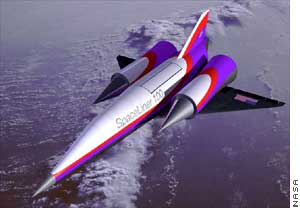
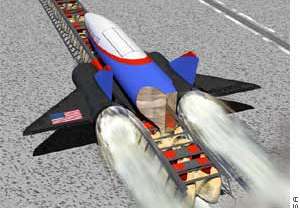
So with a few drawing, I began to scale this rocket. I determined it was best to use 2.6" body tubing and I had a nose cone that would fit the bill. The project was a go!
Construction:
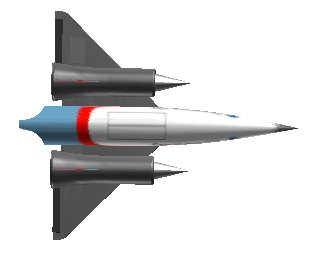 After scaling all the drawing, I cut all
the pieces needed to make the rocket. The tail cone shape was the toughest to
cut, but I did that right in the main 2.6" body tubing.
After scaling all the drawing, I cut all
the pieces needed to make the rocket. The tail cone shape was the toughest to
cut, but I did that right in the main 2.6" body tubing.
The main wing fins were cut from 1/4" Balsa and then a layer of printing paper was laminated on them using 5-minute epoxy. The vertical fins were cut from 1/8" balsa and laminated as well.
The Engine tubes are 1.6". They had a custom rear, outer centering ring made to support the outer shroud. The two hard-balsa engine cones are also custom made to the dimensions derived from scaling the drawings. I utilized two CR5060 centering rings for recessing/mounting these nose cones to the engine tubes. These custom parts were made by Balsa Machining Service. The shroud (not shown) was made by using VCP and printing onto 110lb Card Stock (Georgia Pacific brand purchased from WalMart).
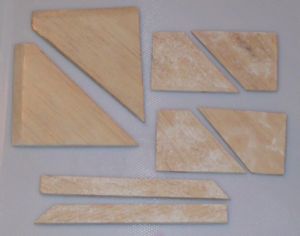
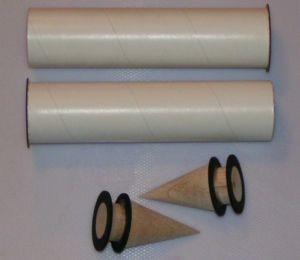
Perhaps a unique technique was used to attach the wings to the engine tubes. Here it can be seen, that large (1/8") holes were drilled in the body tube along the glue line (but not up onto the shroud). Holes were also drilled into the root edge of the 1/4" balsa fin. The holes in the fin were then filled with Gorilla Polyurethane glue and it was also thinning applied to the root edge. Each hole on the tube had a small amount of Gorilla glue put into it using a toothpick. Then the fin was placed onto the line and moved slightly back and forth. It was then taped into place and stood on end. Standing it on end, allowed the glue to flow into the hole and then flow downward, creating a glue "hook". A lot of Gorilla glue is not needed since it expands.
This technique was repeated for attaching the fins to the main body tube.
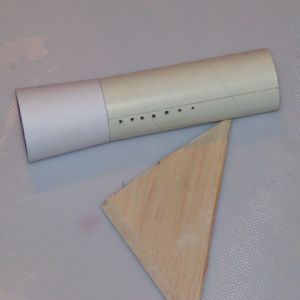
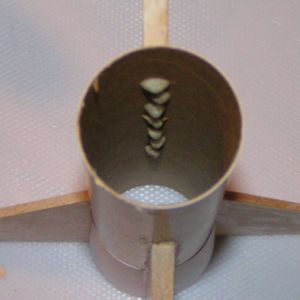
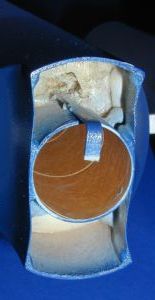 The 29mm Motor Mount
was installed and using 110lb Card Stock, the tail cone was formed. This was
glued in place with wood glue and once dried the back of it was coated with
Gorilla glue for strength. This made it rigid enough to allow filling and
smoothing on the outside.
The 29mm Motor Mount
was installed and using 110lb Card Stock, the tail cone was formed. This was
glued in place with wood glue and once dried the back of it was coated with
Gorilla glue for strength. This made it rigid enough to allow filling and
smoothing on the outside.
I also took and old windshield wiper metal strip, cut and bent it in shape to form the motor retaining hook. I had to push the expanding Gorilla glue away from where the hook flexes.
The Nose Cone's Should-end was cut out, but I'll talk more about that later.
The rest of the construction was straightforward. I did not glue the Engine Nose Cones in place to make finishing easier. From here I moved to finishing.
Finishing:
Using too many to count coats of Gray Plasti-Kote Sandable Primer and sanding between each coat, I was able to work out all the issues. It then was painted using only $0.98/can Wal-Mart Paint. This means that each color was done 1 week after the prior.
I made decals and printed them on Papa-Tango decal paper and applied them. I then installed the Engine Nose Cones. Lastly, I clear-coated the entire rocket with Wal-Mart Clear Coat.
I'm pleased with my finish.
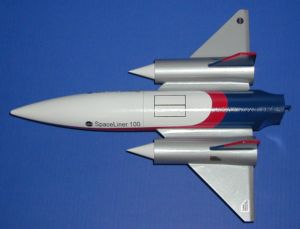
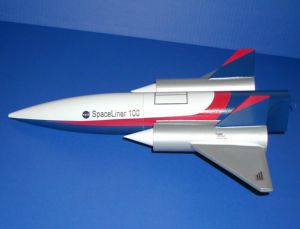
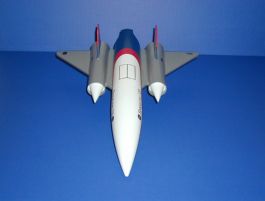
Flight Prep:
Not the easiest model to RockSim, but I made an attempt to determine how much nose weight I needed. I had already prepped the nose cone by cutting out shoulder's bottom. I had found a large eye-bolt and had BB's and epoxy ready. From RockSim, it determined I needed 4 oz of nose weight with a G80 loaded.
I took a drill and long bit and gouged/roughed up the inside of the nose cone where the nose weight was going to be glued in place. After this is tied my shock cord to the eye-bolt and stood it up in the center of the nose cone. I poured in 2 ounces of BB's (for future reference that is about a 1 Liter Wide-mount Pepsi Cap full of BB's). I then mixed up a lot of 5-minute epoxy and poured it in. This was repeated with another 2 ounces of BB's. So I actually ended up adding 4 ounces of BB's, 1.8 ounces from the eye-bolt and all the epoxy.
I added a parachute and heat shield and RailButtons... now it's ready!
Stats:
- 14 3/4" Wing Span
- 18 1/8" Length
- 2.6" Body Tube
- 1.6" Engines going to 1 15/16" flared back
- 21 Ounces
- 28" Parachute
- 29mm Motor Mount
Flight:
After creating a form of a RockSIM, I determined that it should fly nicely with an F52-5 (although I set the CG up to fly with a G80).
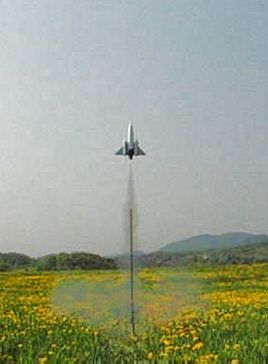
A perfect morning in Vermont, allowed me to get out to the field. I went with one purpose... fly the SpaceLiner 100.
The F52-5 was loaded and the rocket was placed on a Rail. I set up my camera to make a movie clip (wmv - 855k).
It was fast off the pad and flew straight up with a very slow spin. The parachute ejected a bit early. Could have used another 1-2 seconds perhaps. Hard to tell. Descent was excellent and it landed about 20 feet from the pad.
It was begging to be flown again, so I loaded an EconoJet F20-4.
A bit slower coming off the pad. I actually got 5 sequential pictures, but I had set the aperture too low and they are washed out.
Summary:
I'm very pleased with my rendition of the SpaceLiner 100. It is an excellent flier and looks unique. The painting was the greatest challenge, but it turned out to nicely (my own opinion).
 |
 |